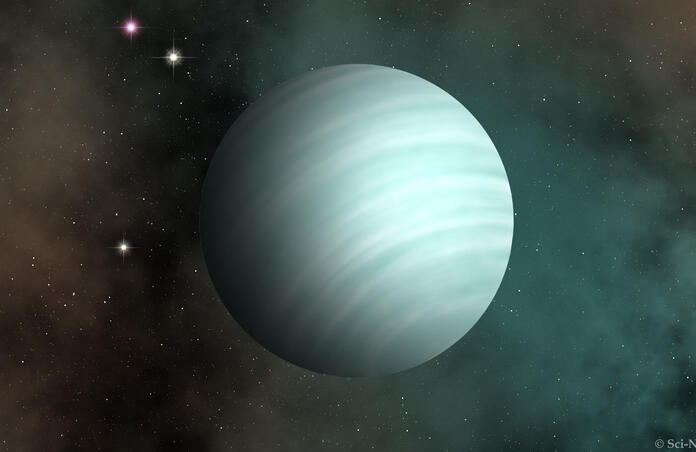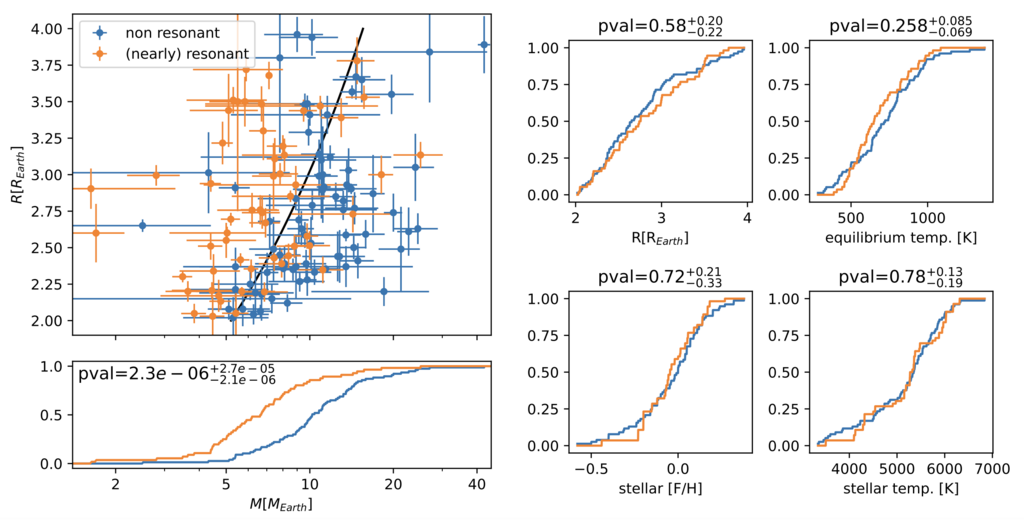Link between density and resonance found for sub-Neptune systems

A new study led by an international team involving scientists from NCCR PlanetS, the University of Geneva and the University of Bern have demonstrated the existence of two distinguishable populations of sub-Neptunes based on density. This has helped to make advancements in an ongoing debate within the exoplanet community on these small worlds.
Sub-Neptunes are the most common exoplanets found in the cosmos, classified as small planets with sizes between Earth and Neptune. However, an issue is apparent when it comes to calculating their density. Two populations seem to form within this regime, based on the method used to measure their mass: less dense and dense. This has sparked the question: is this the result of observational bias, or do two physically distinct sub-Neptune populations exist?
The recent study aimed to aid in our understanding of this problem, finding the latter of the two possibilities to be the case. Overall, to determine the density an exoplanet, the radius and mass must be calculated first. The main problem which arises is that masses determined using Transit Timing Variations (TTVs) are less dense than planets with masses found by radial velocity method.
"The TTV method involves measuring variations in transit timing. Gravitational interactions between planets in the same system will slightly modify the moment at which the planets pass in front of their star," explains Jean-Baptiste Delisle, scientific collaborator in the Astronomy Department of the UNIGE Faculty of Science and co-author of the study. "The radial velocity method, on the other hand, involves measuring the variations in the star's velocity induced by the presence of the planet around it."
However, the team found that majority of the systems measured via the TTV method are in resonance. Resonance occurs between two planets when the ratio between their orbital periods is a rational number. For example, two planets are in 2:1 resonance when one completes two orbits around its star in the same time the other completes one. Additionally, if several planets are in resonance, a chain of Laplace resonances form.
To strengthen the idea of a link between density and resonance, the possibility of observational bias had to be ruled out first. The team meticulously chose systems for statistical analysis. For example, larger, low mass transiting planets need to be observed for longer to be detected by radial velocity. Therefore, this increases the risk of observations being interrupted before the planet is visible in the data, thus before its mass can be calculated.
"This selection process would lead to a bias in the literature in favor of higher masses and densities for planets characterized with the radial velocity method. As we have no measurement of their masses, the less dense planets would be excluded from our analyses," explains Leleu.

The team defined a controlled, unbiased sample of 133 sub-Neptunes observed by Kepler, TESS, HARPS and ESPRESSO. Statistical tests were then run to uncover that the density of sub-Neptunes is lower in resonant systems than those in non-resonance, irrespective of the method used to determine planetary mass. A low probability was found, implying that the mass of resonant planets are not drawn from the same underlying population as the bulk of sub-Neptunes. Additionally, systems closer to resonance tend to be more co-planar than those not in resonance, a trend also seen in synthetic populations.
Several possible explanations have been put forward for this link, however, the main hypothesis stated by the team is that all planetary systems converge towards a resonance chain state early on in their existence, but only 5% remain stable. The resonance chain breaks down for the other 95%, resulting in a series of collisions between planets. Consequently, planets join together, increasing their density where they form a stable, non-resonant orbit. Ultimately, two populations form based on this density.
The numerical models of planetary system formation and evolution that we have developed at Bern over the last two decades reproduce exactly this trend: Planets in resonance are less dense. "This study, moreover, confirms that most planetary systems have been the site of giant collisions, similar or even more violent than the one that gave rise to our moon," concludes Yann Alibert, professor at UNIBE's Space Research and Planetary Sciences Division (WP) and co-director of the Center for Space and Habitability and co-author of the study.
--
Cover image: Sci-News.com
Journal source: Adrien Leleu et al, Resonant sub-Neptunes are puffier, Astronomy & Astrophysics (2024). DOI: 10.1051/0004-6361/202450587
